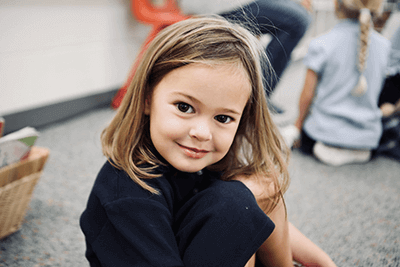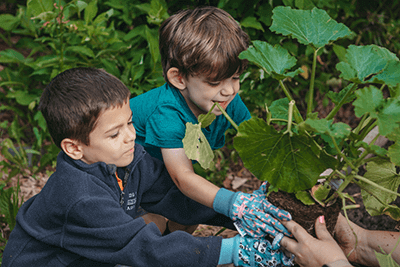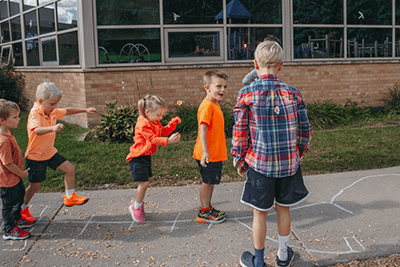October 22, 2025
 The 2025–26 school year marks the 20th anniversary of PreK at Mounds Park Academy. When our program began in 2005 with just 11 students, we could only imagine the vibrant learning community it would grow into. Twenty years later, we have twice as many students and four dedicated teachers who nurture their learning and care each day. Our PreK classroom is a warm, joyful environment where young children learn through play, inquiry, and exploration.
The 2025–26 school year marks the 20th anniversary of PreK at Mounds Park Academy. When our program began in 2005 with just 11 students, we could only imagine the vibrant learning community it would grow into. Twenty years later, we have twice as many students and four dedicated teachers who nurture their learning and care each day. Our PreK classroom is a warm, joyful environment where young children learn through play, inquiry, and exploration.
The Science Behind Early Learning
Looking ahead to the next twenty years, we remain focused on continuous growth and the use of best practices grounded in research. Neuroscience shows that the early years are the most critical in human development. In a 2023 article titled, “Brain Development in Early Childhood,” Dr. Anisa Kelley, a neurologist at Children’s Hospital of Chicago wrote, “There is massive growth and development of the brain in the first couple of years of life–90 percent of brain development is complete by age five.” Similarly, Dr. Rishi Sriram of Baylor University reminds parents that early education is far more than a prelude to “real” learning. “Children’s brains can uniquely absorb information during this critical phase. If intelligence is defined as the ability to learn, children between the ages of two and seven may be the most intelligent humans on the planet.” This makes high-quality early childhood education one of the most powerful investments in a child’s future success.
Our Commitment To Excellence In Early Education
At MPA, one way we uphold this commitment is through accreditation with the National Association for the Education of Young Children (NAEYC), the nation’s leading organization in early learning. As a NAEYC-recognized program, we demonstrate excellence not only in curriculum and teaching, but also in building strong, trusting relationships with families, fostering equity and ethics, and supporting the ongoing growth of our teachers and leaders.
As an independent PreK–12 school, MPA is also proud to be an accredited member of the Independent Schools Association of the Central States (ISACS). The rigorous accreditation process ensures that we are held accountable to the highest educational standards at every grade level. Together, ISACS accreditation and NAEYC recognition affirm our commitment to the very best in education.
NAEYC’s Standards In Action
NAEYC has developed nine standards to identify quality in early childhood programs. Each one is woven into the fabric of MPA’s PreK experience.
- Relationships: Warm relationships with teachers support brain development and help children build their sense of self.
- Families and Community: Families are a child’s first teachers. They play an important role in a student’s education and growth and their culture, language, and traditions all influence learning. MPA values strong partnerships with each student’s parents and caregivers.
- Curriculum: MPA’s uses curriculum that aligns with research, has developmentally appropriate goals, provides a rich variety of content, and is culturally responsive, with the intent of offering the best learning experiences for young children.
- Teaching: Intentional teaching of age-appropriate skills, lessons that are both child-led, and teacher-directed, and a variety of hands-on experiences are all strategies that encourage active learning in young children. MPA promotes learning through play in an environment where all students feel valued and included.
- Assessment: Educators observe and assess students’ progress regularly and use the results to build lessons that match their needs, strengths, and interests. Assessments ensure the program is doing its part to guide students toward learning goals and help educators and families identify students who may benefit from additional support or intervention.
- Health: This goes beyond ensuring the facility is clean and safe; it guides programs to support good nutrition and overall well-being in students and adults. Safety is a top priority and all staff have extensive training in emergency preparedness.
- Physical Environment: Indoor and outdoor learning environments are thoughtfully designed for young children. MPA’s spaces foster active learning, comfort, and safety for students, teachers, and families.
- Professionalism: Educators have specific experience in early childhood education and child development. They create warm relationships and supportive learning environments to help students thrive. Ongoing professional development for teachers keeps them up to date as research evolves.
- Leadership and Management: The program’s leadership ensures a positive, supportive working environment for teachers, designs and implements strong policies that guide their practice, and creates systems that align with the school’s mission and values.
 Learning Through Play And Exploration
Learning Through Play And Exploration
In practice, these standards come to life each day through meaningful learning experiences led by caring early childhood educators. Our learning spaces are intentionally designed to nurture academic, physical, social, and emotional growth. While clear learning outcomes guide us, our curriculum remains flexible and responsive to the unique needs and interests of each child.
In the PreK classroom, teachers thoughtfully observe students’ interests and bring their ideas to life. Teacher Hannah Halvorson invites students to be part of the creation of play areas in the classroom. Noticing that a group of students enjoys pretending to go on trips, she helped them create a city bus in the dramatic play area. The students helped to paint the cardboard structure and write destinations on their rotating sign. “The students have such strong creative and imagination skills,” she says. “We honor this when we let students lead in play and engage in world-building. Open-ended dramatic play helps students develop a sense of ownership in the classroom, expand their verbal skills, and strengthen relationships with one another.”
Teacher Mandi Wilson enjoys finding ways to embed learning into play. “We weave concepts from literacy, numeracy, science, and art into play experiences,” she explains. “This might include a science table where students explore textures or make patterns in an art project. The students often don’t realize they are practicing language or math skills because it feels like play.”
Building Confidence, Compassion, and Community
Each day, you will see young students laughing as they construct castles out of blocks, create masterpieces at the easel, and build friendships as they explore the classroom together. Our students grow as curious, joyful learners who find connection, wonder, and the foundation for a lifetime of learning.
 Teacher Maria Smith focuses on the most important parts of the PreK experience. “Learning how to be a part of a group, manage big feelings, navigate the lunchroom, take turns in a game, and persevere through challenges is just as important as learning numbers and letters. At this age, students are learning how school works, and we are here to help set them up for success.”
Teacher Maria Smith focuses on the most important parts of the PreK experience. “Learning how to be a part of a group, manage big feelings, navigate the lunchroom, take turns in a game, and persevere through challenges is just as important as learning numbers and letters. At this age, students are learning how school works, and we are here to help set them up for success.”
Looking Ahead To The Next 20 Years
The story of MPA’s PreK program is rooted in a steadfast commitment to care for young learners. From its beginnings two decades ago, it has become an important part of our PreK-12 community. Our teachers and families share a deep belief in the power of high-quality early childhood learning.
As we celebrate this 20-year milestone, we look to the future with great excitement and a passion for excellence. Inspired by the mission and values that have guided us from the beginning, we will continue to hold ourselves to the highest standards so that our students can always dream big and do right.